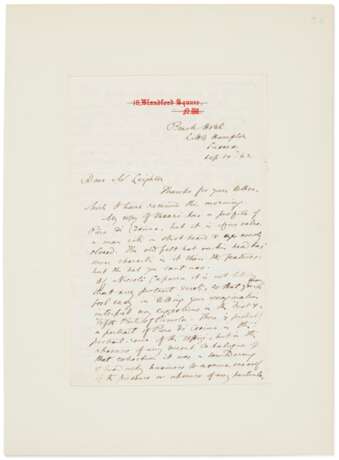ID 627634
Lot 145 | Autograph letters to Frederic Leighton
Estimate value
$ 5 000 – 7 000
Together nine pages (180 x 115mm), window-mounted.
"Approximate truth is the only truth attainable": on Leighton’s illustrations for Romola. Eliot writes in the first letter that she has "confirmed … my conclusion that gannurra was the equivalent of our gown i.e. the constant outer garb of femininity, varying in length & cut according to rank & age ... If you are going to see Ghirlandajo’s [sic] frescoes – the engravings of them I mean – in the choir of Santa Maria Novella, I wish you would especially notice if the women in his groups have not that plain piece of opaque drapery over the head which haunts my memory." She goes on to suggest that artistic representations at the time would have moderated the excesses of extravagant dress ("hideous & extreme fashion"), and compares the woman’s "berretta" with a contemporary bonnet. She concludes with self-deprecation: "I trouble you with this note … in order to indicate to you the very slight satisfaction my anxiety on this subject can meet with … Approximate truth is the only truth attainable, but at least one must strive for that." The second letter discusses the availability of portraits of Piero di Cosimo and other characters in the novel, and reflects on Leighton’s proposal to change his model for Romola, "It will be much better to continue what is intrinsically pretty than to fail in an effort after something indistinctly seen." She goes on to reflect on the delicate relationship between writer and illustrator, "I am quite convinced that illustrations can only form a sort of overture to the text," but assuring him that "I appreciate very highly the advantage of having your hand & mind to work with me." The letter concludes with a diversion on the subject of verbal derivations.
Romola was the only one of Eliot’s novels to be illustrated on its first appearance: Frederic Leighton, then a rising artist, may well have been chosen for the task because he had lived in Florence, where the novel was set. He completed 24 illustrations in all for the serial publication in The Cornhill Magazine, as well as initial letters and a tail-piece. . Provenance: letter of 5 June 1862 sold at Spink-Smythe, 6 June 1996, lot 358; both letters sold as part of lots at Sotheby’s New York, 2 June 1995, lot 107, and Phillips London, 24 October 1985, lot 587.
| Artist: | William Shakespeare (1564 - 1616) |
|---|---|
| Applied technique: | Pencil |
| Artist: | William Shakespeare (1564 - 1616) |
|---|---|
| Applied technique: | Pencil |
| Address of auction |
CHRISTIE'S 8 King Street, St. James's SW1Y 6QT London United Kingdom | |
|---|---|---|
| Preview |
| |
| Phone | +44 (0)20 7839 9060 | |
| Buyer Premium | see on Website | |
| Conditions of purchase | Conditions of purchase |












